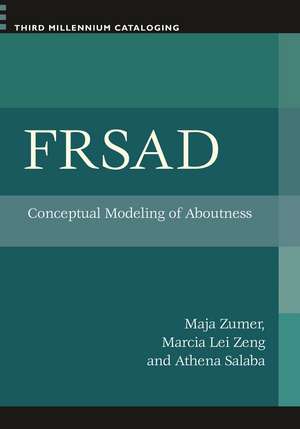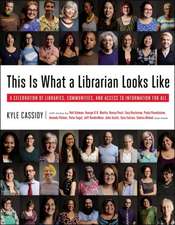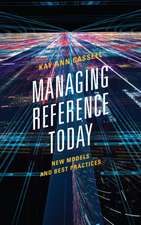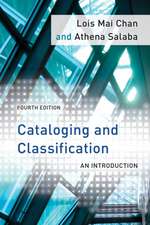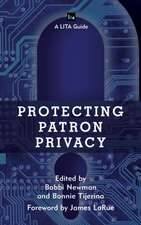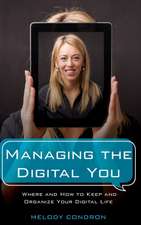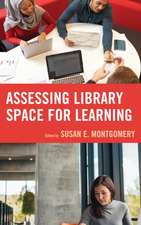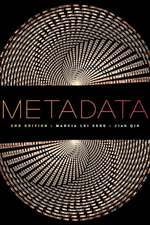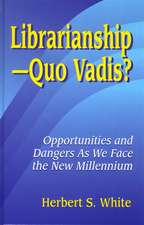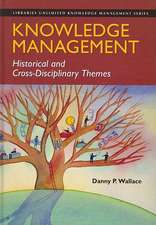FRSAD: Conceptual Modeling of Aboutness: Third Millennium Cataloging
Autor Marcia Lei Zeng, Athena Salaba, Maja Zumeren Limba Engleză Paperback – 10 sep 2012 – vârsta până la 17 ani
Preț: 262.32 lei
Preț vechi: 320.39 lei
-18% Nou
Puncte Express: 393
Preț estimativ în valută:
50.19€ • 52.55$ • 41.53£
50.19€ • 52.55$ • 41.53£
Carte tipărită la comandă
Livrare economică 07-21 aprilie
Preluare comenzi: 021 569.72.76
Specificații
ISBN-13: 9781598847949
ISBN-10: 1598847945
Pagini: 132
Dimensiuni: 178 x 254 x 5 mm
Greutate: 0.27 kg
Editura: Bloomsbury Publishing
Colecția Libraries Unlimited
Seria Third Millennium Cataloging
Locul publicării:New York, United States
ISBN-10: 1598847945
Pagini: 132
Dimensiuni: 178 x 254 x 5 mm
Greutate: 0.27 kg
Editura: Bloomsbury Publishing
Colecția Libraries Unlimited
Seria Third Millennium Cataloging
Locul publicării:New York, United States
Notă biografică
Maja Zumer is professor in the Department of Library and Information Science and Book Studies at the University of Ljubljana, Slovenia.Marcia Lei Zeng is professor in the School of Library and Information Science, Kent State University, Kent, OH.Athena Salaba is associate professor at the School of Library and Information Science, Kent State University, Kent, OH.
Cuprins
ContentsChapter 1: Introduction References Chapter 2: Aboutness Aboutness: Overview Aboutness and Ofness Form, Genre, and Isness The Common Needs that Structured Vocabularies Serve References Chapter 3: Users and Use of Subject Authority Data Who Are the Users of Subject Authority Data? User Studies and Their Use of Subject Authority Data Use of Subject Authority Data by Vocabulary Creators Use of Subject Authority Data at the Creation and Maintenance of Data: Metadata Creators Use of Subject Authority Data when Searching for Data: End Users and Public Services Information Professionals Use of Subject Authority Data by Computer Applications FRSAD User Tasks The FIND Task The IDENTIFY Task The SELECT Task The EXPLORE Task References Chapter 4: Modeling Approaches of Aboutness Functional Requirements for Bibliographic Records (FRBR) Discussion Functional Requirements for Authority Records (FRAD) Discussion Examples of Other Modeling Approaches Ranganathan's Facets Information Coding Classification by Dahlberg Buizza and Guerrini FAST References Chapter 5: The FRSAD Model User Tasks OutlineEntities Thema NomenRelationships Basic Relationships between Entities Thema-to-Thema Relationships Nomen-to-Nomen Relationships Attributes Thema Attributes Nomen Attributes References Chapter 6: Formal Presentations of the FRSAD Model Recapitulation of FRSAD FRSAD in RDF References Chapter 7: Examples of Subject Authority Data Explained with the FRSAD ModelExamples of Display Records from Knowledge Organization Systems Example: A Thema and Its Nomens in a Simple Controlled List from the PBCore instantiationColors Example: A Chemical Substance and Its Nomen-A Display Record from the USP Dictionary of U.S. Adopted Names and International Drug Names (USAN) Example: A Place as a Thema-A Display Record from the Getty Thesaurus of Geographic Names (TGN) Example: Taxonomy with Notations-An Extracted Section from the GAMS Problem Taxonomy Example: A Thesaurus Editing Tool View of a Record from the ASIS&T Thesaurus Example: A Multilingual Thesaurus Record from the Thesaurus Ethics in the Life Sciences Example: A Display Record (Expanded Concept View) from MeSHExplanations of FRSAD's Major Components with Examples Existing Models of Thema Types Thema-to-Thema Relationships Presented in Subject Authority Data in Individual Vocabularies Thema-to-Thema Relationships Crosswalked through Nomens in Multiple Knowledge Organization SystemsSame Thema Represented by Nomens from Different SchemesReferences Chapter 8: Use of FRSAD for Knowledge Organization Structure Development and InteroperabilityFRSAD for Knowledge Organization Structure Development Implications of FRSAD for Various Knowledge Organization Structures FRSAD for Authority Data in General FRSAD for Meeting Multilingual and Multiple Community Needs FRSAD Model for Vocabulary Mapping Approach 1: Nomen-hosting System Approach 2: Thema-centered System The FRSAD Conceptual Model and Its Implementation in Data Models for Subject Authority Data SKOS and the Thema-Nomen Relationship Model SKOS eXtension for Labels (SKOS-XL) and Relationships of Nomens References Chapter 9: Concluding RemarksReference Index
Recenzii
The book provides a thorough overview of the theoretical foundations of knowledge organization as well as working guidelines for its implementation. . . . Primarily geared for catalogers in academic institutions, the work also teaches how to make decisions that impact the catalog and, more generally, how to search a catalog. It also provides information on using the FRSAD model when developing knowledge organization systems both in the library and beyond.
